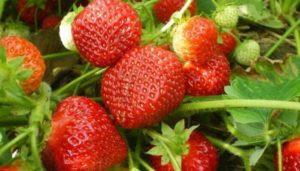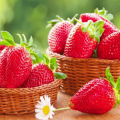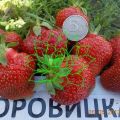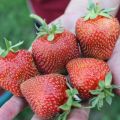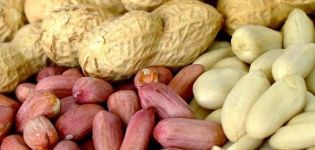Description and characteristics of the Kimberly strawberry variety, cultivation and reproduction
When cultivating Kimberly strawberries, you can feast on healthy tasty berries quite early, since the variety is classified as early ripe. The plant is unpretentious, resistant to powdery mildew. To obtain a high-quality harvest, it is necessary to observe a number of nuances and requirements for reproduction and planting. Thanks to its dense fruits, the berry can be stored for several days, it tolerates transportation well.
Description and characteristics of a popular variety
Wima Kimberly is a strawberry hybrid. Bushes of the plant are strong, stocky, powerful. The leaf plates are rounded with a pleasant oily color. Inflorescences are located at the level of leaf plates or below. The mustache grows slowly, for high-quality fruiting, they are removed as they grow.
Berries
The berries are quite large, up to 50 g, conical. They have a bright red tint and characteristic shine. Berry with a rich, bright taste, reminiscent of caramel, with a pleasant aroma. The fruits are rich in sugars, but the taste is not sugary. It is easy enough to transport, the berries do not become soft, do not crack, do not have voids inside.
Yield
With proper care, the yield per bush is up to 2 kg. Strawberries will yield a good harvest if the garden is hidden from the north wind.
Sustainability
The plant is resistant to common diseases, tolerates temperature drop and mild frost perfectly. It is affected by brown spot.
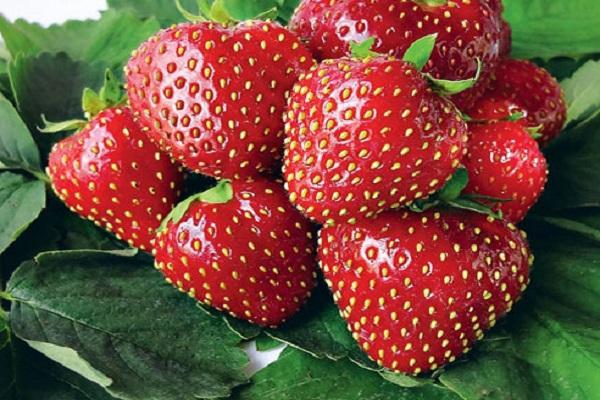
Origin and region of cultivation
This Dutch variety is recognized as early. Obtained by crossing Gorella and Chandler. This plant will be ideal for cultivation in continental latitudes. It is worth considering that the plant can freeze out in frosty winter, respectively, in the northern regions it needs to be covered.
Pros and cons
The positive traits of this strawberry include:
- drought resistance;
- frost resistance;
- early maturity;
- increased productivity;
- large fruits;
- immunity to powdery mildew;
- despite the excessive moisture in the soil, the berries do not become watery.
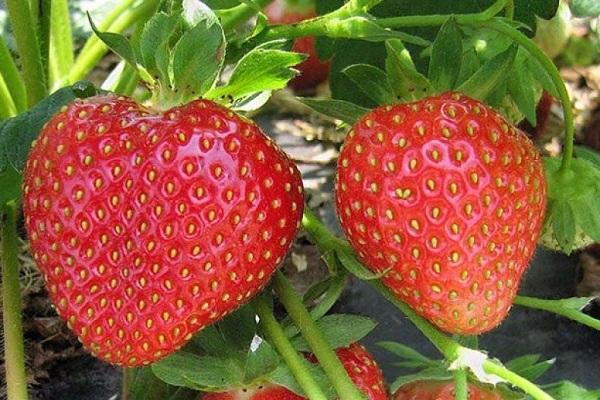
Minuses:
- the bush requires sufficient lighting;
- the amount of harvest and the size of berries are reduced under the influence of unfavorable weather factors;
- the plant is affected by brown spot, harmful insects;
- only the first fruits of the season are large, after which they gradually become smaller;
- when cultivating bushes in a greenhouse, taste indicators fall.
The nuances of planting and breeding Kimberly strawberries
Each plant variety has its own cultivation characteristics. Kimberly has the following nuances:
- Planting of bushes is carried out in the first spring days or at the beginning of the autumn period. When planted in spring, strawberries take root well, but you should not expect a harvest. Planting before winter should not be delayed, the optimal time is September, the plant should take root.
- You need to plant the bushes on a flat area. It is not recommended to plant in lowlands, the roots will be affected by rot.
- If it is planted on the southern slopes, it may die. The water comes off quickly, the plant will be deprived of a sufficient amount of moisture. Kimberly needs moist soil.
- The plant requires regular watering, especially in dry climates.
- The first 7-10 days after planting strawberries need daily watering.
- Before planting, the soil must be cleared of weeds.
- The bushes are not large, the optimal distance between them is 0.25-0.3 m.
- Sandy loam and loamy substrate is suitable.
- The garden bed must be prepared a week before planting strawberries: dig up, remove weeds, apply fertilizer (humus, urea, sand).

How to plant with seeds
Seed material for germinating strawberries must be purchased from a trusted manufacturer in special stores or prepared independently.
For good seed:
- Pick up a large, healthy berry.
- Cut off a thin layer of skin with a sharp knife, put on a paper sheet, let dry.
- Soak in warm water for a day before sowing.
- Prepare loose soil from earth, peat and sand. Fill the planting container with them.
- For germination, it is important to make stratification - to simulate winter conditions. To do this, sprinkle the ground with snow, then lay out the seeds. You should not cover with a layer of soil, the snow will melt and pull the seeds into the soil.
- Cover the container with a transparent lid, send to the cold.
- After 2 weeks, place the container in a warm place.
- It is necessary to moisten the soil as it dries.
- When the plant has two true leaves, remove the lid.
- Pick plants.
- Plant young bushes in the ground when there is no fear of repeated frost.

How to plant a mustache
This breeding method is considered the most effective:
- A well-developed rosette, first to the mother bush, attach to the soil. Remove the rest of the antennae. It is recommended to use only the first socket.
- By the end of summer, the rosettes will take root, get stronger. They must be separated from the main bush, cut off the antennae with scissors if it has not rotted away.
- Remove the sockets with a clod of earth. Transplant to a new location.
How to propagate through dividing the bush?
Suitable for all varieties, especially those that do not form a mustache or give them in small quantities.
It is necessary:
- dig a bush four years old;
- remove dying and dry leaves;
- shake off the soil;
- place in a container with water;
- carefully divide the bush;
- if the horn turns out to be double (two on one root), it must be cut in half;
- cut off old, dry roots of the plant;
- remove peduncles;
- plant in pots and keep in greenhouse conditions for 3 to 6 weeks;
- plant in prepared soil.
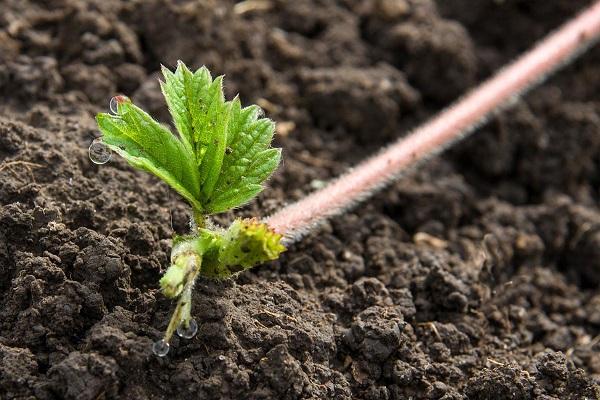
Strawberry care rules
Compliance with the rules of care, watering, feeding, removing antennae will help to increase the yield of strawberries.
Watering, weeding and loosening the soil
The variety is quite drought tolerant. But this does not mean that he does not need constant and abundant watering. The plant will tolerate lack of moisture for 2-3 days. Watering is carried out in dry weather every two days, the bush needs from 3 to 5 liters.
After watering, it is important to loosen the soil and remove weeds. It is recommended to mulch the soil.Drip irrigation is considered an effective method of moisturizing.
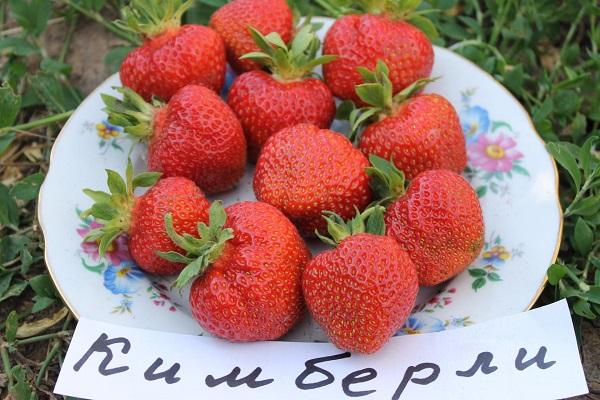
Fertilization
The plant needs a large amount of nitrogen in the initial stages of growth and organic components during fruiting. During the season, the plant must be provided with three dressings. Use infusion of mullein or chicken droppings. Mineral dressings are important:
- In the spring: urea and ash.
- Before flowering: in addition to organic feed, apply Agricola or Ovary.
- After fruiting: superphosphate or nitrophosphate. Spread the drug over the ridges, loosen.
Role of mulch
A method of agricultural technology that facilitates labor and prevents the development of diseases. It consists in covering the surface of the soil under the bushes with organic and inorganic materials. This will protect the soil from the adverse effects of the environment, increase the reproduction of beneficial organisms, worms, which, in tandem with organic acids, create fertile soil. Mulch prevents the development of weeds, protects the roots from drying out, frost, overheating.
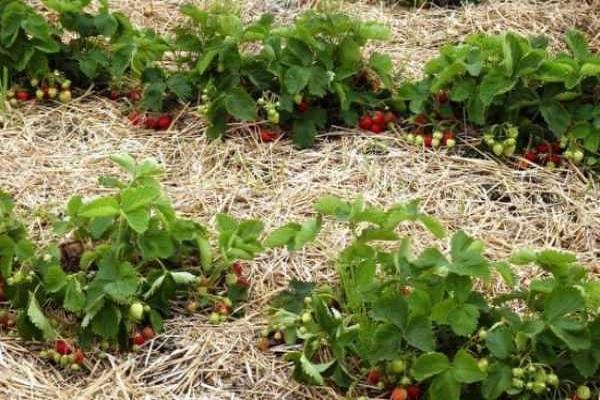
Pruning garden strawberries
Shrubs left without pruning grow rapidly, which creates favorable conditions for insects and the development of diseases. At the same time, the berries become smaller, their number decreases. The antennae pull most of the nutrients towards themselves. They should be left only for seedlings, the rest should be removed.
Rules for pruning bushes:
- carried out in dry weather;
- morning or evening time;
- do not tear off the shoots, but cut them off so as not to injure the bush;
- cut off not under the place of growth, but at a distance of 5-10 cm from it.
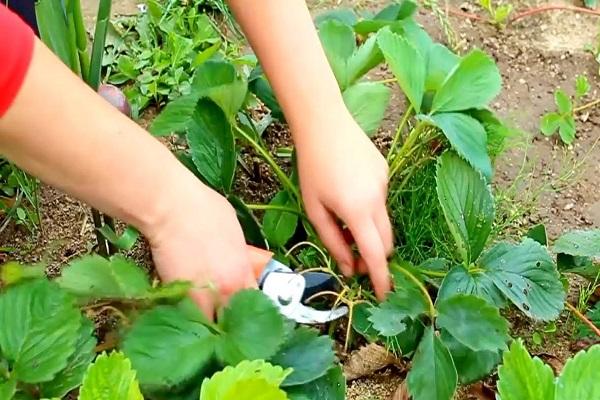
Preparing for winter
After harvesting, the plants are prepared for wintering. Leaves and whiskers must be removed. Before the onset of frost, clear the bushes, leaving only the stems. Treat the cut points on the plant with a fungicide.
When cold weather sets in, the bushes must be covered. Spruce branches are ideal. This will trap the snow.
How to protect a berry from diseases and pests?
This variety has good immunity to powdery mildew. But he is affected by brown spotting. Bushes can overcome: weevils, spider mites, nematodes.
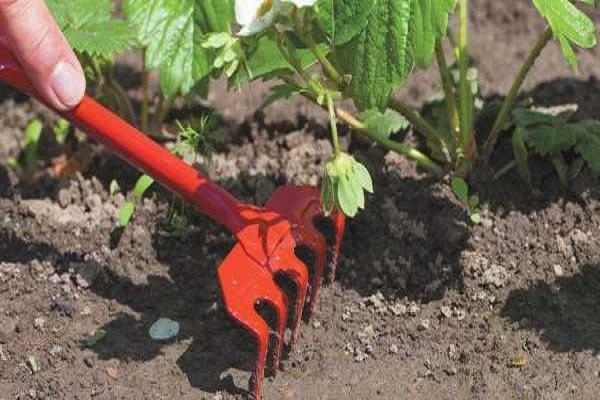
To prevent disease or damage by harmful insects, it is recommended for prophylactic purposes to treat plants with a solution of garlic infusion.
In case of diseases or insect damage, it is recommended:
- Brown spot: before the formation of buds and after removing the fruits, treat the bushes with "Topaz" or Bordeaux liquid.
- Strawberry mite: spray the bush and soil with "Fitoverm" or "Aktofit" before the appearance of fruits and after their collection.
- Weevil: treat with a decoction of tobacco dust, red pepper, mixed with a soap solution.
- Strawberry nematode: impossible to kill. Remove bushes with roots, burn. Do not plant strawberries in this place for about 5-7 years.

Collection and storage of strawberries
Since the flesh of the fruit is dense, it turns out to be transported over long distances. When the strawberries are being prepared for transportation, the berries should be picked slightly unripe with a light end. The collection is carried out together with a part of the peduncle. This will allow you to maintain a beautiful view for several days. It is recommended to store at a temperature not exceeding +5 aboutFROM.
